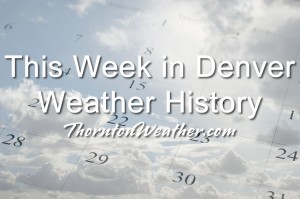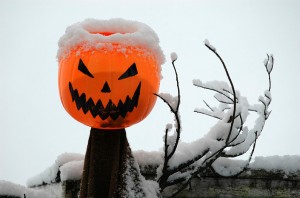
Powerful, damaging winds, heavy snow and the first official weather observation in the Mile High City highlight this week in Denver weather history.
From the National Weather Service:
14-18
In 1964…the first measurable snowfall of the season totaled 6.0 inches at Stapleton International Airport where northeast winds gusted to 32 mph on the 14th. Most of the snow…4.2 inches…fell on the 14th. This was the only measurable snow of the month.
15-17
In 1991…a strong winter storm dumped heavy snow over metro Denver. Snowfall amounts totaled 15 inches at Castle Rock and Conifer…14 inches at Morrison and Parker…12 inches in southeast Aurora…and 11.6 inches at Stapleton International Airport. Winds were light with the storm.
16-17
In 2010…the combination of heavy snow and strong winds produced dangerous driving conditions in the high country. Blizzard conditions forced the closure of U.S. Highway 6 at Loveland pass and U.S. Highway 40 at Berthoud Pass. Blowing and drifting snow forced the closure of a 65-mile stretch of Interstate 70…west of Idaho Springs. Peak wind gusts included: 68 mph atop Niwot Ridge…55 mph near Blackhawk and Gunsight…and 52 mph at Berthoud Pass. Storm totals in the ski areas west of Denver ranged from 12 to 21 inches. Northwest winds gusted to 55 mph at Denver International Airport on the 16th.
In 2010…the combination of snow and strong winds produced dangerous driving conditions in the mountains west of Denver. Near blizzard conditions forced the closure of U.S. Highway 6 at Loveland pass and U.S. Highway 40 at Berthoud Pass. Blowing and drifting snow closed a 65-mile stretch of interstate 70…between Idaho Springs and Vail Pass. Peak wind gusts included: 68 mph atop Niwot Ridge…62 mph at Loveland Pass…55 mph near Blackhawk and 52 mph at Berthoud Pass.
16-18
In 1921…heavy snowfall totaled 6.5 inches over downtown Denver. This was the only measurable snow of the month. East winds were sustained to 14 mph on the 17th.
17
In 1948…a dry vigorous cold front accompanied by north winds gusting to 60 mph produced extensive blowing dust…which briefly reduced the visibility to 1/2 mile at Stapleton Airport.
In 1993…a wind gust to 70 mph was recorded atop Squaw Mountain near Idaho Springs.
In 1994…winds gusted to 66 mph in Boulder and to 63 mph on Rocky Flats south of Boulder. West winds gusted to 49 mph at Stapleton International Airport.
In 2000…snow fell in the foothills west of Denver…mainly south of the I-70 corridor. Snowfall totals included: 8.5 inches…7 miles south of tiny town; 6 inches at Genesee; and 5 inches…11 miles southwest of Morrison. Only a trace of snow was recorded at the site of the former Stapleton International Airport.
17-18
In 1869…the heaviest wind storm in 5 or 6 years raked the eastern foothills including Boulder…Denver…Georgetown… And Golden. Some hundreds of dollars in damage occurred in Boulder.
18
In 1872…fresh west winds contributed to the relative humidity dipping to zero at 2:43 pm. The maximum temperature was 54 degrees.
In 1907…heavy snowfall totaled 6.0 inches over downtown Denver. Snow fell all day. North winds were sustained to 19 mph.
In 1915…northwest winds were sustained to 42 mph with gusts as high as 48 mph. It was windy most of the day.
In 1996…high winds struck the foothills west of Denver. Wind gusts ranged from 70 to 75 mph. A few power lines were downed…but no major outages were reported.
In 1998…strong downslope winds developed during the morning. Wind gusts reached a peak of 72 mph at Jefferson County Airport near Broomfield. West winds gusted to 41 mph at Denver International Airport.
In 1999…high winds developed in and near the Front Range foothills. The strong winds downed power lines…which sparked several small brush fires. In Broomfield… Scaffolding was damaged at the Wadsworth Recreation Center…while flying rocks broke several windows at a local bank building. Peak wind gusts included: 91 mph atop Blue Mountain near Wondervu…88 mph atop the Gamow Tower on the University of Colorado campus in Boulder… 83 mph at Jefferson County Airport…81 mph at the National Center for Atmospheric Research mesa lab above Boulder…and 80 mph at Wondervu. West-northwest winds gusted to 48 mph at Denver International Airport.
Continue reading November 17 to November 23: This Week in Denver Weather History

